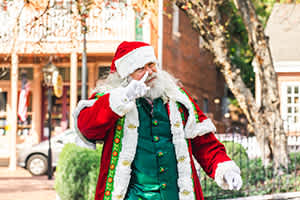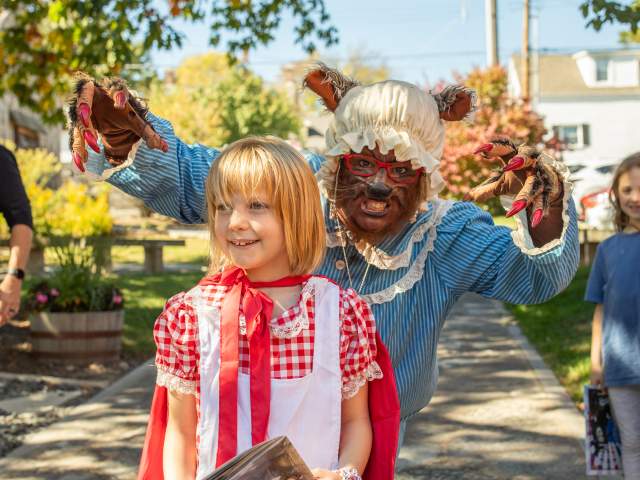Meet Our Ghostly Guests!
We’ve been conjuring up some serious hocus pocus to make this All Hallow’s Eve season one you’ll never forget.
During Legends & Lanterns® the most notorious villains, phantoms, and ne’er-do-wells from history and folklore have unleashed the magic of their enchanted lanterns in order to travel through time and space, and have decided to make Saint Charles their new favorite “haunt.” These ne’er-do-wells have assembled during their favorite time of year to take you on a truly spellbinding adventure!
Swap recipes with the dastardly Mrs. Lovett, learn the origins of your favorite Halloween traditions with the Druid Priest, brainstorm story ideas with the Brothers Grimm, get hair care tips from Medusa, and craft the perfect alibi with Lizzie Borden & the Big Bad Wolf.
A wand-erful assortment of macabre memories await you.
Hexes & O’s,
Merlin & Morgana Le Fay
MERLIN: Wizard, fortune teller, advisor…perhaps mythology’s most famous magician, Merlin is most known for his role in the legend of King Arthur. Merlin’s first literary appearance was in the 1136 book Historia Regum Britanniae (“History of the Kings of Britain”) by Geoffrey of Monmouth. Soon after, various bards, poets, and writers expanded on Arthurian lore (and by extension, the story of the famous sorcerer). A master of the magical arts and potions, it was Merlin who planted the famous sword in the stone, (prophesizing its extraction by the boy king for whom he would act as a mentor). According to legend, it was also Merlin who constructed the renowned Round Table of Camelot. Though considered by most to be a myth, Merlin was inspired by a real-life figure: Myrddin Wyllt, a court advisor for a sixth-century king, known for his ability to see into the future.
MORGANA Le FAY: A pivotal character of Arthurian lore, the story of this enigmatic fairy sorceress varies greatly depending on the source material. In later works, Morgana Le Fay is depicted as powerful and incredibly dangerous. Having learned her magic from the wise wizard, Merlin, she becomes enamored with the dark arts, and seeks to use her malevolent powers for evil. After developing a seething hatred of Queen Guinevere, Morgana Le Fay is banished from Camelot. She then retreats to her magical kingdom of Gorre, where seeking revenge, the enchantress plots to steal the magical sword Excalibur and bring about the downfall and demise of Arthur and his queen, allowing for her to claim the throne and rule the kingdom.
THE WONDERFUL WIZARD OF OZ: Prior to becoming “Oz the Great and Terrible,” Oscar Zoroaster Phadrig Isaac Norman Henkle Emmanuel Ambroise Diggs was a simple conman and circus magician from Omaha, Nebraska. After his iconic hot air balloon unexpectedly floated into the enchanted Land of Oz, he used his talents for smoke and mirrors to present himself as a powerful sorcerer and soon became the supreme leader of Oz (ruling from his palace in the Emerald City). Aside from his introduction in the 1900 book The Wonderful Wizard of Oz, author L. Frank Baum includes the character of the Wizard in several other books in his Oz series. Baum may have been inspired by a real-life figure, Washington Harrison Donaldson (a magician who worked for P.T. Barnum). On July 15, 1875, Donaldson ascended in a hot air balloon near Chicago, and disappeared into a storm. Neither he nor the balloon were ever seen again.
THE WICKED WITCH OF THE EAST: In L. Frank Baum’s classic 1900 fairy tale, The Wonderful Wizard of Oz, Dorothy, a young farm girl from Kansas, finds herself in a fantasy land ruled by witches (both good and bad). Though she is often overshadowed by her ferocious green-skinned sister, the Wicked Witch of the West, the Wicked Witch of the East was a powerful force for evil in her own right. As the governor of Munchkinland, she terrorized the tiny people of Oz, ruling over them with an iron first, until the fateful day Dorothy’s cyclone-blown farmhouse “dropped in” on her. Though she only appears briefly in Baum’s story (and the subsequent 1939 MGM movie musical), her fashion sense is instantly recognizable, with her striped stockings and enchanted slippers that were commandeered by Dorothy, taking her on that familiar journey down the yellow brick road.
IMHOTEP (27th Century BCE): Chancellor to Pharaohs, architect, high priest of the sun god Ra, magician…these are only a few of the roles that the powerful Imhotep performed in life during Egypt’s third dynasty. Upon his death, Imhotep’s body went through the process of mummification. Following the discovery of Tutankhamun’s tomb in 1922, modern society began an obsession with ancient Egypt. In 1932, the legend of Imhotep was reincarnated when Boris Karloff portrayed him as the antagonist in the Universal monster classic The Mummy. Nearly 70 years later, Hollywood revisited The Mummy franchise in a 1999 blockbuster that featured an undead Imhotep releasing plagues upon Egypt (and Brendan Fraser) in his quest for world domination.
BETTY PARRIS (1682-1760): The daughter of village minister Samuel Parris, Elizabeth “Betty” Parris became the first of the “afflicted girls” of Salem, Massachusetts whose accusations led to the arrest and imprisonment of more than 150 innocent people as witches during the infamous Salem Witchcraft Hysteria of 1692. In the end, the judgments of the sham trials sent 19 individuals to hang on Gallows Hill (and one to be pressed to death under heavy stones). Some experts speculate that fungus-infected rye may have led to hallucinations that Betty Parris and others believed to be witchcraft. Betty Parris never apologized for her role in the tragedy.
CAPTAIN JAMES HOOK: The terror of Neverland, Captain James Hook was first brought to life in 1904 when Scottish novelist J.M. Barrie first debuted his tale of Peter Pan. This quick-tempered pirate commander provided a fitting archenemy to the sprite-like boy who wouldn’t grow up and soon joined the rank of legendary fictitious buccaneers alongside the likes of Long John Silver. As elegant as he is bloodthirsty, the ruthless Captain Hook is known for his fanciful outfits and is instantly recognized by the hooked appendage on his arm (his hand having been eaten by a crocodile that provides a continuous source of anxiety for the pirate). Sailing aboard the notorious vessel the Jolly Roger, Hook and his bumbling crew of cutthroats dominate the uncharted waters and mermaid lagoons of Barrie’s fantasy island, as they tangle with the various tribes and Lost Boys of Neverland who get in the way of the Captain’s pursuit of the impish Peter Pan.
ANNE BONNY (1697-?): Proving that piracy was not exclusively a boys’ club, Anne Bonny was one of history’s few female buccaneers. Born in County Cork, Ireland, as a young woman, she met the eccentric Captain “Calico Jack” Rackham, and became seduced by a life of piracy. Bonny and Calico Jack terrorized the Caribbean aboard their commandeered ship The William. With her battle axe in hand, Anne Bonny was known as a ferocious fighter. Her flaming red hair was just an outward manifestation of her fiery temper. On November 15, 1720, as The William came under attack, she shot at her own crew for being too inebriated to fight back. The whole crew (including Anne) were apprehended and sentenced to hang, with her famous last words to Calico Jack being “had you fought like a man, you need not have been hanged like a dog.” While history is unclear of her fate, it is believed that she escaped execution and lived into old age in Charles Towne (now Charleston), South Carolina.
THE SIREN: Seafarers have long been prone to superstition. Since the dawn of the ocean voyage, nearly every culture has had its own unique menagerie of sea monsters to be wary of (such as the legendary Kraken). However, among the deadliest of nautical adversaries are the Sirens. These mythic menaces use their hauntingly beautiful singing voices to hypnotize sailors, causing their ships to crash and sink, as the Sirens lure the men to their watery demise.
EDGAR ALLAN POE (1809-1849): “Quoth the Raven, nevermore!” This excerpt is just one of the many chilling passages that have cemented Edgar Allan Poe as America’s master of horror. Known for his poetry and short stories, Poe is beloved for his tales of mystery and the macabre including The Raven, The Tell-Tale Heart, and The Cask of Amontillado. Poe died under mysterious circumstances in Baltimore, Maryland on October 7, 1849. Beginning in 1949, an unknown visitor known as the “Poe Toaster” began making an annual pilgrimage to Poe’s grave, raising a toast with a glass of cognac and leaving three roses. The tradition continued for six decades until January 19, 2009, when the Poe Toaster made its final appearance…on Edgar Allan Poe’s 200th birthday.
THE WEIRD SISTERS: “Double, double, toil and trouble. Fire burn and cauldron bubble,” one of the most famous quotes in English literature is uttered by these three witches in William Shakespeare’s 1606 tragedy, Macbeth. Throughout the play, the titular Scotsman consults the soothsaying crones, who prophesize everything from Macbeth’s bloody rise to become king of Scotland to his eventual downfall and demise. English author, J.K. Rowling has mentioned Macbeth to be her favorite Shakespeare play and gained inspiration from the three witches while writing the Harry Potter series. Fans of the books may recall a band called “The Weird Sisters” that make minor appearances in several books (and are spotted onscreen in Harry Potter and the Goblet of Fire). Composer John Williams even used the familiar spell “double, double, toil and trouble” as lyrics to a song that appears in the third film.
THE QUEEN OF HEARTS: Hold on to your head! This hot-tempered sovereign from Lewis Carroll’s 1865 fantasy novel Alice’s Adventures in Wonderland has a nasty habit of settling disputes by severing heads for the most minor offense. Known for her dislike of white roses, love of tarts, and her penchant for playing croquet (with flamingos as mallets and hedgehogs in lieu of croquet balls), this majestic menace has garnered a reputation for her cruelty, making her a frightful foe for Mad Hatters, Cheshire Cats, and young girls named “Alice.”
MARY WOLLSTONECRAFT SHELLEY (1797-1851): A literary pioneer and feminist icon in early 19th century England, Mary Wollstonecraft Shelley is best known for authoring what is arguably the most iconic novel of the horror genre. While on a trip to Lake Geneva in May of 1816, dreary weather kept her travel party indoors. In a bout of cabin fever, the group entertained each other with a competition to see who could write the best ghost story. It was from this challenge that nineteen-year-old Mary penned the short story that would become Frankenstein: or, A Modern Prometheus. In 1818, her tale of a scientist’s successful attempt to reanimate a corpse was published; horrifying and capturing the imagination of readers around the world. Though she wrote many other novels, her enduring gothic novel, Frankenstein has stood the test of time and spawned countless motion picture adaptations (everything from a 1910 silent film to Mel Brooks’ 1974 comedy Young Frankenstein).
VLAD “THE IMPALER” TEPES (1431-1477): Given the nickname “Vlad the Impaler” by his enemies, the ruthless Vlad Tepes was the Prince of Wallachia (now Romania) and a member of the House of Draculesti. Famed for his extravagant cruelty, accounts of his barbarism (including a rumor that he drank blood) quickly spread throughout Europe. The legend of this imposing figure inspired a young writer named Bram Stoker to pen his 1897 novel Dracula. To date, the villainous Count has appeared in more motion pictures than any other horror character (with over 200 film credits). Vlad Tepes is believed to have died in battle around 1477, his final resting place is unknown.
BABA YAGA: As the most famous witch in Slavic folklore, Baba Yaga forgoes the stereotypical pointed black hat and broomstick of conventional witches, and instead flies through the night sky in a giant mortar. This old crone resides deep in the forest in a hut called “Izbushka” that spins around on a giant chicken leg. Like an ethereal earth mother, she has a strong connection to her woodland surroundings, but like nature, she too can sway from being kind and gentle to wild and untamed. So beware, the mysterious Baba Yaga may either help or hinder those who seek her out.
ULCHABHÁN: The Druid Priest: Many of the beloved traditions of Halloween originated with the ancient Druids. All Hallow’s Eve began as the Gaelic festival of Samhain, which marked the end of the harvest season and the beginning of winter, the darker half of the year. It was during Samhain that it was believed the veil between the worlds of the living and the dead was lifted. Gifts of food were left to appease the Aos Si (the spirits or fairies that could cross over into the living realm), and many individuals would disguise themselves in animal pelts in an effort to avoid being recognized by any malevolent spirits. This practice (eventually called “mumming” or “guising”) morphed into what we know today as trick or treating. Several centuries later, the Church, in an attempt to draw attention away from the Pagan festival of Samhain, established a holiday the next day (November 1st) called All Saint’s Day (known by the Middle English name, Allhallowmas). Hence, Samhain became All Hallow’s Eve, or in its shortened form: Halloween.
MEDUSA: Amid the pantheon of gods and monsters throughout Greek mythology, few figures are as feared as the Gorgon named Medusa. Once a strikingly beautiful priestess, she incurred the wrath of Athena (goddess of wisdom, arts, and war) who cursed Medusa with a hideous transformation. The young priestess found her hair turned into a nest of venomous, writhing snakes, and her gaze made so abhorrent that it could turn onlookers to stone. Repulsed by her grotesque metamorphosis, and embittered from being shunned by the world, an enraged Medusa soon became the monster that her outward appearance suggested.
BIG BAD WOLF: Who’s afraid of the Big Bad Wolf? Whether making a meal out of Little Red Riding Hood’s grandmother, committing property damage while terrorizing the Three Little Pigs, or lending a musical threat to Peter and the Wolf, this woodland beast has provided storytellers with a formidable foe for generations. While contemporary audiences may regard these fables with nostalgia, they were received quite differently when they first appeared. When European peasants were first introduced to the adventures of Little Red Riding Hood in the 10th century, the Big Bad Wolf provided an enemy both on and off the page (where many villages found vicious wolf attacks to be an unfortunate reality). The stories also stood as a cautionary tale of the dangers of straying into the wilderness (medieval Europeans and early American settlers were very superstitious of untamed woodlands which they considered to be evil and mysterious).
ICHABOD CRANE: In 1820, author Washington Irving published what would become the quintessential classic American ghost story: The Legend of Sleepy Hollow. The tale follows the supernatural misfortunes of ill-fated Ichabod Crane, the quiet hamlet’s new schoolmaster. Along the way, the eternally nervous and devoutly superstitious Crane makes the acquaintance of a colorful cast of characters, including the charming Katrina van Tassel and the gruff town bully Brom Bones. Late one Halloween night, while riding home from a party through the Western Wood, Ichabod has his worst fears confront him as he encounters Sleepy Hollow’s most famous undead resident: the terrifying Headless Horseman. The next morning, the schoolmaster’s hat was discovered in the woods alongside a smashed pumpkin. Ichabod Crane was never seen in Sleepy Hollow again. Did he escape to another village? Or did he become a victim of the Headless Horseman?
THE WICKED STEPSISTERS: Vain and outrageous, these two selfish sisters know no bounds to the torment they thrust upon the stepsibling they mockingly call “Cinderella” (a cruel nickname they give her in reference to the fact that she is constantly covered in soot and cinders from sweeping out the fireplace). In 1697, French author Charles Perrault first published his fairy tale Cendrillion which took a more light-hearted approach to the story (and ended with the stepsisters being forgiven and each being married to a wealthy man). One hundred-fifteen years later in 1812, the Brothers Grimm took their characteristically dark approach when they retold the story under the German title Aschenputtel. The garish sisters meet a more gruesome fate when they attempt to fool the Prince. In order to squeeze their large feet into the heroine’s famous slipper (which in the Grimm version is golden, not glass) they cut off their toes and heels. Unsuccessful in their attempt, these haughty damsels then crash the royal wedding in order to win favor from their stepsister-turned-future-queen, yet while there, they are blinded when a flock of magical birds pecks out their eyes.
MARTIAN INVADERS: Forget about Area 51, Saint Charles is the new hotspot for extraterrestrial encounters. Having beamed down from outer space, hijinks are bound to ensue as these two inquisitive visitors from the Red Planet commence their mission to search for intelligent life. These alien ambassadors will probe and observe the curious behaviors of Earthlings in order to bring back their findings (and perhaps a specimen or two) to their home planet. But fear not, these intergalactic delegates come in peace…or do they? Inspired by the quirky alien villains that antagonized heroes in dozens of science fiction B-movies of the 1950s, these beings pay a retro homage to the cult classics spurred by the midcentury space race.
LIZZIE BORDEN (1860-1927): Did she or didn’t she? Acquitted for the infamous 1892 axe murders of her father and stepmother in Fall River, Massachusetts, Lizzie never quite convinced history of her innocence. The sensationalized dramatics of the courtroom led Lizzie to become an overnight celebrity, and for the trial to dominate conversation around the country. After the trial, Borden decided to remain in Fall River (though she was greatly ostracized by the community). The story of Lizzie Borden was immortalized in a famous school rhyme. The exact identity of who crafted the poem is unknown, but some folklore points to the author as being a renowned nursery rhyme personality, Mother Goose.
GINGERBREAD WITCH: As one of the most nefarious villains from the fairy tales of the Brothers Grimm, this old crone has been teaching children not to take candy from strangers since 1812. When German siblings Hansel and Gretel are left in the woods by their father and stepmother, they are entranced by a house made entirely of gingerbread and sweets. They are tricked into entering the sugary abode by a witch who in turn forces Gretel to be a servant and locks Hansel in a cage (fattening him up to make a meal out of him). When Gretel pushes the witch into an oven, the children are able to make their daring escape.
SWEENEY TODD & MRS. LOVETT: Victorian readers looking for a quick thrill would often turn to “penny dreadfuls,” (serialized horror stories sold weekly for a penny). An 1846 penny dreadful titled The String of Pearls introduced the world to the ghoulish tale of Sweeney Todd. Nicknamed the “demon barber of Fleet Street,” the vengeful Todd lured over 150 victims into his tonsorial parlour with the promise of “the closest shave” they would ever know. What happened to them was a mystery. Curiously, Todd’s fiendish accomplice, an entrepreneurial widow named Mrs. Lovett soon had a booming business selling meat pies (made using a “secret ingredient”) to unsuspecting customers. The chilling account of the dastardly pair has since been adapted into silent films, television programs, and stage plays, most notably a blockbuster Stephen Sondheim Broadway musical (and its subsequent Tim Burton motion picture adaptation).
DORIAN GRAY: A libertine and a Victorian playboy, Dorian Gray first came onto the scene as the primary character in Oscar Wilde’s 1890 novella The Picture of Dorian Gray. In the story, the vain and hedonistic aristocrat expresses a desire to sell his soul so that his painted portrait would age, allowing him to remain young and handsome. The wish is granted, and the figure in the painting becomes increasingly grotesque and reflects the vices and sins that he commits.






